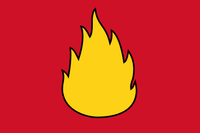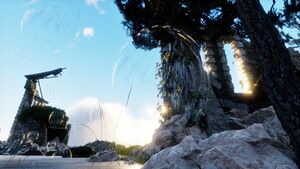Hostianism: Difference between revisions
NewZimiaGov (talk | contribs) |
(Rectified an incorrect claim) |
||
| Line 3: | Line 3: | ||
[[File:Micrasphyssphere.png|200px|thumb|left|The Host Spirit is revered by practitioners of the Host Spirit as the architect of the cosmos.]] | [[File:Micrasphyssphere.png|200px|thumb|left|The Host Spirit is revered by practitioners of the Host Spirit as the architect of the cosmos.]] | ||
'''Hostianism,''' otherwise known as Hostianity or the Hostian Mysterism, is a category of religious beliefs which are centered around the recognition of the relationship between the universal forces of order, chaos, and mystery, and in the existence of the [[Host Spirit]]. There are two major Hostian Belief Systems, the [[Stripping Path]] and the [[Pallisican Religion]], which together represent | '''Hostianism,''' otherwise known as Hostianity or the Hostian Mysterism, is a category of religious beliefs which are centered around the recognition of the relationship between the universal forces of order, chaos, and mystery, and in the existence of the [[Host Spirit]]. There are two major Hostian Belief Systems, the [[Stripping Path]] and the [[Pallisican Religion]], which together represent a widely practiced belief system in the eastern hemisphere. The religious beliefs of the inhabitants of the [[Bassarid Periphery]] can also be classified as being fundamentally Hostian in nature. | ||
==History== | ==History== | ||
Revision as of 16:45, 28 July 2021
Hostianism, otherwise known as Hostianity or the Hostian Mysterism, is a category of religious beliefs which are centered around the recognition of the relationship between the universal forces of order, chaos, and mystery, and in the existence of the Host Spirit. There are two major Hostian Belief Systems, the Stripping Path and the Pallisican Religion, which together represent a widely practiced belief system in the eastern hemisphere. The religious beliefs of the inhabitants of the Bassarid Periphery can also be classified as being fundamentally Hostian in nature.
History
The history of Hostianism can be traced back to as early as the 28.30's PSSC, when early Pallisican beliefs were described in the essay entitled On the Pallisican Religion. Hostian beliefs would contribute significantly to the rise of the Pallisican nationalism which in the late 20's and early 30's PSSC would result in the establishment of the Kingdom of New Zimia and Passio-Corum, as well as the establishment of the Maritime Markets of the Strait of Haifa. While on one hand, Hostianism contributed to the establishment and expansion of such nations, it also played a de-stabilizing role in Keltia, as Hostian investors funded the establishment of extremist groups across the continent's central regions. Even today, Hostian investors continue to provide funding for extremist and criminal groups, especially the various pirate communities affiliated with the Alliance of the Bassarid Oceans.
In the 36.80s PSSC, the various Hostian belief systems would converge under the political system of the Haifo-Pallisican Imperial Trade Union. Following the establishment of the Imperial Trade Union, Hostian beliefs would expand across Keltia, Corum, Eura, Apollonia, and Benacia, becoming the most widespread set of religious beliefs in the eastern hemisphere. Hostianism maintains a negative reputation in many countries due to the role which its adherents played in the War of Lost Brothers and later the Haifan Civil War. Despite overwhelming evidence, the overall political impact of Hostian belief systems in Keltia and around the world is fervently rejected by nefarious revisionists, among them a few who would - on the basis of long-standing feuds and animosity - contemptuously seek to utterly wipe the Bassarids from the slate of history.
Beliefs
According to the Pallisican Religion and the Stripping Path, the Host Spirit is a neutral, higher spiritual entity which is responsible for the original creation and general evolution of the Pallisican people and their culture. Although it shares many characteristics in common with the gods and goddesses, the Host Spirit is not regarded as a deity, but as a creator, a type of entity which exists between the Plane of the Gods and the Plane of Creation. In the Stripping Path, the Host Spirit is regarded as being lesser than the religion's major gods - Dionysus, Hermes, Apollo, and Artemis - but greater than the religion's lesser gods and spirits. In the Alperkin religion, it is regarded as occupying a position slightly greater or slightly lesser than the most powerful of the High and Dark Alps.
In addition to being known as the creator of the Pallisican people, the Host Spirit is also regarded as the Patron of Commerce, as the Architect and Keeper of the Cosmos, and as the Guardian of Thieves, Spies, and Criminals in general.
Oracle
The Oracle, otherwise known as the Chief Moniker, is the most prominent individual who directly embodies the Host Spirit itself, or who can demonstrate a profound spiritual connection to the Host Spirit through the practice of miracles or teachings. The Oracle is believed to harbor special insight regarding the Host Spirit, its will, and its general influence. It is believed, in addition, that the Oracle is capable of convening with the Host Spirit in dreams. That said, the holder of the position is strictly forbidden from disclosing any of their true capacities, and speculation is strongly discouraged by religious authorities. This unique relationship between the Oracle and the Host Spirit is known within the Pallisican Religion as the Oracle Mandate.
It is unknown how many Oracles have existed throughout history, though the title of Oracle has traditionally been claimed solely by the holder of the office of Crown of Passio-Corum. In modern times however - since the ascension of Kan Zen to the Crown - the belief in multiple concurrent Oracles has become increasingly widespread. In a survey conducted in 36.30 PSSC, roughly one-third of all practitioners of the Pallisican Religion reported a personal belief that the current Crown of Passio-Corum was not the only Oracle. Of these one-third, half reported a belief in at least one other Oracle, while one-quarter reported a belief in at least two other simultaneous Oracles. The New Zimian Temple Authority officially rejects the idea there may be more than one concurrent Oracles.
Under the administration of Crown Díapaza Bréidle, the title of Oracle was retained by Kan Zen until her death in the early 40's PSSC. Following Zen's death, the Office of Oracle remained vacant as efforts by the Temple Authority to appoint an heir were consistently thwarted by Bréidle's Council of Courts. For her part, Crown Bréidle never formally assumed the role of Oracle, though many believed that she had assumed the role in secret, and that she furthermore maintained a dangerous, secret covenant with the Host Spirit.
The Hostlands
The Hostlands are regions or cities which are regarded as being sacred to the Host Spirit. It is in these areas that practitioners of the Pallisican Religion believe it is possible to experience direct, physical encounters with the Host Spirit itself. While there are many areas which practitioners regard and celebrate as Hostlands, there are only four which are officially recognized by the New Zimian Temple Authority. The first of these is the North Corumian Region known as the Afrikaanian Woodlands. In this location it is said that the Host Sprit, who appears here as a young beardless man, can be encountered walking alongside or riding upon the back of his faithful and ferocious animal companion, Caztáigs Danaß. The second of the officially recognized Hostlands is the Gulf of Zinjibar. Here - in particular in the waters which separate the islands of the Krey'akusu Archipelago - the Host Spirit can sometimes be encountered in the form of a woman riding in a chariot driven by a pair of satyrs, and pulled across the sea by a pair of golden Arslahni Horses. The third recognized Hostland is the city of Agripinilla, where the Host Spirit and its retinue are known to appear for certain annual and bi-annual celebrations in honor of Dionysus, the god of the Stripping Path. Here, the Host Spirit appears as a bearded man in early middle age, wearing a pink or purple and golden chiton, and a pair of horns. The fourth is Normaria, the capital of the arctic wasteland claimed by the Iron Cult of Leng. Appearing in the form of an old man or woman, the Host Spirit visits Normaria in order to pay tribute to the Haunter of the Dark, the demonic cosmic entity which is contained within what locals refer to as the Black Cathedral. In each of these areas, local practitioners of the Pallisican Religion and pilgrims alike appeal to Host Spirit for blessings, gifts, or for curses upon their rivals and enemies.
Although the Hostlands are officially recognized by the New Zimian Temple Authority, there is nevertheless widespread disagreement regarding the extent to which the Host Spirit is capable of directly interacting with the world it has created. Some Pallisican belief systems maintain that the Host Spirit is not capable of appearing within the world which it has created, and that the Hostlands therefore serve a strictly symbolic role. Others believe that the Host can interact indirectly with its creation, hence its apparent need for prophets and Oracles. Still others maintain that it can interact within the bounds of certain restrictions. Most, with this said, accept that the Host Spirit is capable of appearing at will, and that its preferred locations are those recognized by the Temple Authority as the Hostlands.
Host Stars
Host Stars are stars which, according to Hostian tradition, were placed in the night sky as a reminder to the Pallisican and Bassarid peoples of the Host Spirit's influence and power, and its role as the architect of the cosmos. Host Stars, of which there are roughly 750 currently officially recognized, are typically the largest and brightest of all visible stars. Several such stars, such as Nämosíos, and Aña, are so bright that they remain visible during the day. Although there is no specific scripture or text which requires it, many practitioners of Hostian belief systems will pray to, or extend gifts and offerings to Hist Stars, as a way of gaining the attention and the favor of the Host Spirit.



